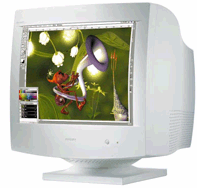
| HOME | TIPS & TRICKS | ARTICLES | RESOURCES | DIRECTORY | SITE MAP |
| Creating your graphics
Back to top
Screen captures The most important considerations for screen captures are size, file format, and available tools. Size of screen captures Width should be 572 pixels or fewer, and height should be 800 pixels or fewer. Image resolution should be 72 dpi (dots per inch), standard optimization for the Internet. Please take all screen captures as closely as possible to these dimensions. Any image larger than 572 x 800 pixels will either be resized (screen capture) or redrawn (illustrated image) by the graphic design team to fit these dimensions, which could adversely impact readability. In general, it's best to take the smallest screen capture possible by adjusting the size of the browser window to include only the information you need to capture. Don't alter the original screen capture. Include the original file when you submit your manuscript; it will be revised to fit within the layout. File formats for screen captures The best format to use for saving your screen captures (source files) and delivering to your editor is one that is not optimized or compressed; in other words, avoid the 24-bit .bmp and the .tif format. Typically, the .gif (Graphics Interchange Format) format is best for publishing screen captures and is optimized for high-contrast graphics, such as application interfaces. A common error is to use the .jpg (Joint Photographic Experts Group) format for screen captures, but this can cause legibility problems and enlarge the file size. As a rule, images that use a few flat colors are usually best saved as a .gif. For complex images, such as photographs that use many shades and gradations between colors, a .jpg can provide significantly smaller file sizes than a .gif can. The graphic designer will revise the source file to the appropriate format. Tools for screen captures Several screen-capture applications are available for all software platforms. In general, you're free to use the tools you're most familiar with. We cannot provide technical support for screen-capture applications, but we do recommend that you use the built-in screen capture tools specific to your platform. In most cases, the tools that come with Microsoft® Windows®, Apple Macintosh, and Linux® are sufficient for screen captures. (If you need to capture something other than a screen, such as the cursor or pointer, you might need another application.) Remove all toolbars prior to taking the screen capture. (For example, on a PC, select View > Toolbars > Unselect all toolbars. On a Mac, select View > Collapse Toolbars.) For tips on saving and delivering your screen captures to your developerWorks editor, see File formats for screen captures. |
Copyright 2025 Freetechnique.com All rights reserved.
|
 Graphics you can create for your article or tutorial include screen captures, technical illustrations, and photographs.
Graphics you can create for your article or tutorial include screen captures, technical illustrations, and photographs.